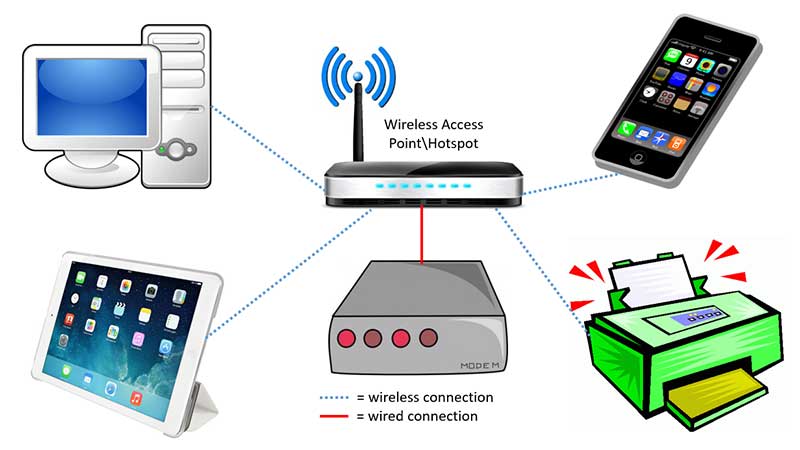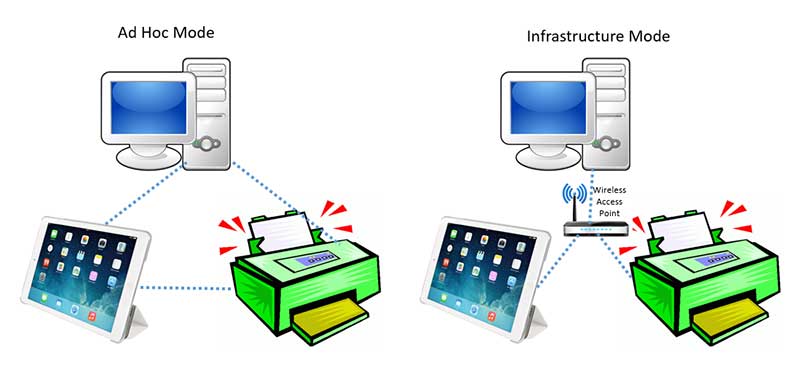Learn the history of wireless technology and how it works
By now everyone knows what Wi-Fi is and uses it on their computer, smartphone or tablet to connect to the internet and wireless printers etc. But how does wireless work and how did we get to where we are today? It wasn’t as easy going as it is now or as fast either but with big leaps in technology we have it pretty good now.
Let’s start with a basic talk about what wireless networking is and how it works. Wireless networking or Wi-Fi (Wireless Fidelity) is the process of transferring data wirelessly as in through the airwaves. It uses radio waves at different frequencies to send data from one device and receive it at another device. And by device we mean things like computers, smartphones, tablets, printers and so on. And just like with cabled networking each device needs to be able to connect to each other and communicate in order for this to work. Things such as firewalls and permissions can stop this communication just like on a wired network.
In most cases you will have a device in between each device commonly called a hotspot or access point. Each device will be connected to this hotspot and it will allow wireless communication to happen between the devices. These access points will commonly be connected to the network infrastructure via network cabling connected to a switch or other network device. For example your home wireless router would be connected to your broadband modem with a network cable allowing your wireless devices to access the Internet via the modem. You can also have access points connecting to access points to extend your wireless signal. These are called range extenders.
Here is an example of a typical wireless network you would find in your home. The Internet comes in via the modem and is connected to the wireless access point so the Internet connection can be shared with all your wireless devices. Since the printer is connected to the access point and the computer is connected to the access point they can communicate with each other to allow for wireless printing.

Wireless Standards
Now that the simple stuff is out of the way let’s talk about wireless standards and how they have changed throughout the years. Wireless standards were put in place by the Electrical and Electronic Engineers (IEEE) to ensure wireless device manufacturers were all on the same page and that their devices would be compatible with each other. Over the years these standards improved features such as range and speed. These are just the main ones and there are many other ones in between that were never really put into place.
Back in 1997 the 802.11 wireless standard was put into place. But it only supported a maximum network bandwidth of 2 Mbps (megabits per second) and therefore didn’t last very long.
The replacement for 802.11 was called 802.11b and came out in 1999 and offered bandwidth up to 11 Mbps. 802.11b uses a 2.4Ghz (gigahertz) frequency which doesn’t cost much to produce but one of the downsides is that other electronic devices such as cordless phones and microwaves that use the same frequency can interrupt the wireless signal.
Along with 802.11b was 802.11a but it wasn’t widely accepted because of the cost. It was adapted more in business situations where they needed the faster speed and could afford the higher cost. It has a speed of 54 Mbps and uses a 5 GHz frequency which helps reduce interference from other wireless devices.
Next came 802.11g which came out in 2002 and also offers 54Mbps speed but uses the 2.4 Ghz frequency to obtain a greater range. They were also able to tweak things a little to help out with the interference problem with the 2.4Ghz frequency.
Then in 2009 came 802.11n which used multiple antennas and signals to increase bandwidth and range. This technology is also called MIMO (multiple input, multiple output). 802.11n has a much higher speed at 300Mbps and better range than the older standards. Itis also backward compatible with 802.11b and 802.11g devices.
Then came 802.11ac in 2013 which had speeds of 450 Mbps on the 2.4 GHz frequency and 1300 Mbps on the 5 GHz frequency. It also has Multi-user MIMO (MU-MIMO) technology and is backwards compatible with the b, a and g standards as well.
Ad hoc mode and Infrastructure mode
There are a couple of different ways you can connect your wireless devices and each has their advantages. These modes are called Ad hoc and Infrastructure.
Ad hoc mode (also known as peer to peer) allows each wireless device to communicate with each other without needing a hotspot or access point. This is great if you don’t want to rely on a centralized access point but one downside is that these devices can only communicate with other devices and not an access point. Security is not as robust as with using an access point because there is no central point of access. Setup can be easier since there is no access point involved so if you have 2 devices that support ad hoc mode they can communicate directly with each other. But on the downside each device has to establish a connection with every other device it intends to communicate with rather than just the access point.
Infrastructure mode is where each wireless device connects to an access point and then all the devices on the network communicate with each other via this access point. This mode is usually faster than Ad hoc mode and security is increased as well. Plus using infrastructure mode allows you to connect the access point to a wired network so wireless devices can access resources on that network. Infrastructure mode is better for a network that will stay in place and be up for an extended period of time. But if the central point of communication (access point) goes down then nobody is talking with anybody.

SSID (service set identifier)
If you have ever setup a wireless connection you have most likely setup an SSID during the setup process but if you haven’t we will go over what an SSID is and what it is used for. SSIDs are the user friendly name given to an access point or hotspot that identifies its owner or location. You may have noticed that when you go to someplace like Starbucks an look at the active wireless connections one might say something like Starbucks Public and that tells you that it belongs to the Wi-Fi connection at Starbucks. This name can be changed on your wireless router if you know how to get into it and change the wireless settings. That way you can make it easier to identify your home Wi-Fi or on the other hand make it harder to identify it if you put something like your neighbors name! One thing to remember is to never have your wireless password match your SSID or even be similar because you don’t want people trying to break in and use your connection or get on your network. Some access points will even let you hide the SSID so it’s not broadcast and you can manually connect to it by from your devices.
There is a lot more to wireless than what we just covered but for your average computer user it would be overkill to talk about unless you were taking a networking course and wanted to learn more about it. Cisco even has a certification based on wireless technology (CCNA Wireless).






